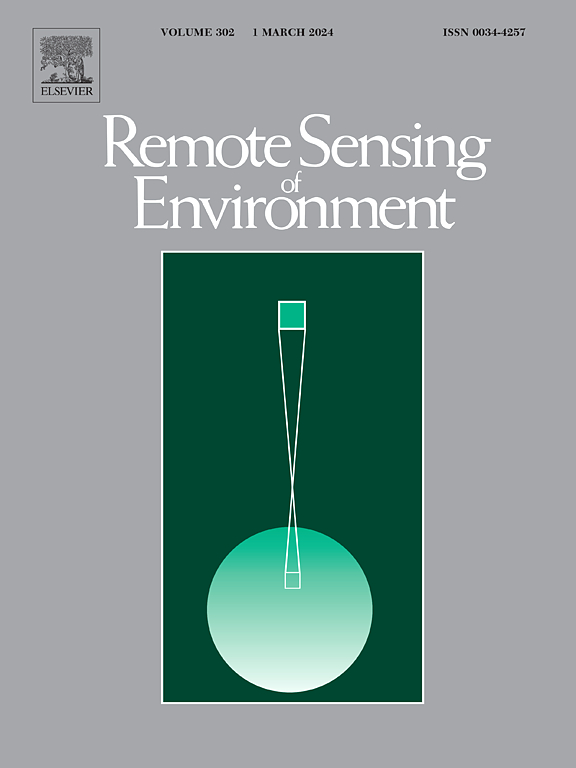Influence of data and methods on high-resolution imagery-based tree species recognition considering phenology: The case of temperate forests
IF 11.1
1区 地球科学
Q1 ENVIRONMENTAL SCIENCES
引用次数: 0
Abstract
Seasonal phenological transformations alter tree appearances, notably by influencing the size and color of the foliage. It has long been anticipated that such phenology induced characteristics can help address the tree-species recognition problem, a fundamental challenge in forest science. Yet, studies on tree-species recognition using remote sensing and phenological characteristics have been rare, due to the very limited availability of high spatiotemporal resolution observations. Moreover, the interactions between the effectiveness of phenological characteristics, remote sensing data, and the analytical methodologies have not yet been sufficiently explored. The understanding of how to integrate multi-temporal observations and phenological characteristics in tree-species recognition has been lacking. This study aims to identify principles for optimizing species recognition by combining data, methods, and phenological dynamics. This involves understanding the impact factors of various methodologies, and how they interact with phenological characteristics and datasets at different times and/or frequencies. The study was carried out using multi-temporal high-resolution optical images of a temperate forest, which were collected in 2021 during leaf growth and senescence periods between May and October, i.e., three leaf growth (May–August) and three leaf senescence (September–October) periods. The test site comprised 14 different tree classes, including 11 species, 2 genera, and 1 dead tree class. The experimental results showed that, for deep learning approaches, the current main limitations in the tree species recognition lie in sample imbalance as the targeted species number increases. With the state-of-the-art data and methods, distinguishing between species within a same genus is much more challenging than differentiating between species from different genera or families. It is also revealed that the best timing for tree species classification is early autumn (September) or late spring (May) when a single-temporal (one-timepoint) data is applied; all-temporal (six-timepoint) data improves the recognition results in comparison with single-temporal observations; however, the improvements from adding additional timepoints became marginal after two timepoint are used with one from late spring and other from early autumn. Furthermore, prior knowledge of individual crown boundaries, typically obtained through individual tree crown delineation, is essential for efficiently incorporating phenological variations into species recognition.
考虑物候的数据和方法对基于高分辨率图像的树种识别的影响:以温带森林为例
季节物候变化改变了树木的外观,特别是通过影响树叶的大小和颜色。长期以来,人们一直期望这种物候诱导的特征可以帮助解决树种识别问题,这是森林科学的一个基本挑战。然而,由于高时空分辨率观测资料的可用性非常有限,利用遥感和物候特征进行树种识别的研究很少。此外,物候特征的有效性、遥感数据和分析方法之间的相互作用尚未得到充分的探讨。在树种识别中,如何将多时相观测与物候特征相结合一直缺乏认识。本研究旨在结合数据、方法和物候动力学来确定优化物种识别的原则。这包括理解各种方法的影响因素,以及它们如何在不同时间和/或频率下与物候特征和数据集相互作用。研究采用2021年5 - 10月,即5 - 8月三叶生长期和9 - 10月三叶衰老期,采集的温带森林多时段高分辨率光学图像。试验点共有14个不同的树类,包括11种,2属,1个死树类。实验结果表明,对于深度学习方法来说,目前树种识别的主要局限在于随着目标树种数量的增加,样本不平衡。利用最先进的数据和方法,区分同一属内的物种比区分不同属或科的物种更具挑战性。在单时间点数据下,树种分类的最佳时机是初秋(9月)或晚春(5月);与单时间点相比,全时间(六个时间点)数据改善了识别结果;然而,在使用两个时间点(一个来自春末,另一个来自初秋)后,增加额外时间点的改进变得微不足道。此外,个体树冠边界的先验知识通常是通过单个树冠圈定获得的,对于有效地将物候变化纳入物种识别至关重要。
本文章由计算机程序翻译,如有差异,请以英文原文为准。
求助全文
约1分钟内获得全文
求助全文
来源期刊

Remote Sensing of Environment
环境科学-成像科学与照相技术
CiteScore
25.10
自引率
8.90%
发文量
455
审稿时长
53 days
期刊介绍:
Remote Sensing of Environment (RSE) serves the Earth observation community by disseminating results on the theory, science, applications, and technology that contribute to advancing the field of remote sensing. With a thoroughly interdisciplinary approach, RSE encompasses terrestrial, oceanic, and atmospheric sensing.
The journal emphasizes biophysical and quantitative approaches to remote sensing at local to global scales, covering a diverse range of applications and techniques.
RSE serves as a vital platform for the exchange of knowledge and advancements in the dynamic field of remote sensing.
 求助内容:
求助内容: 应助结果提醒方式:
应助结果提醒方式:


